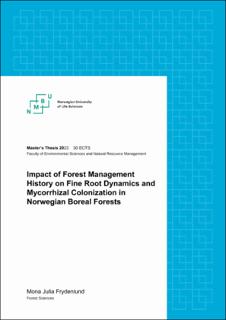| dc.description.abstract | This thesis examines the influence of forest management history on fine root traits in Norwegian boreal spruce forests, focusing on the role of fine roots in carbon sequestration. The study was conducted across various forest sites in southeastern Norway, incorporating contrasting forest management histories – near-natural forests (NN) with minimal human influence and mature forests with a history of clear-cutting (CC). The research aimed to assess the impact of forest management practices on fine root specific root length (SRL), biomass distribution, and mycorrhizal associations.
The methodology included soil sampling and fine root analysis using scanning and statistical techniques. Despite initial hypotheses suggesting significant differences in fine root traits between NN and CC forests, the findings revealed minimal variations attributable to past forest management practices. Neither microclimatic nor macroclimatic factors, including forest structure, significantly influenced these traits.
Contrary to expectations, SRL was found to be similar across both forest types, challenging the hypothesis that management practices in CC forests might significantly influence SRL of fine roots. Although variations in fine root biomass distribution across soil layers were noted, these were not directly associated with forest types. Furthermore, the anticipated increase in root tip abundance and mycorrhizal associations in NN forests, attributed to greater tree species diversity and more complex ecosystem structures, was not observed.
The study contributes to the understanding of below-ground ecological dynamics in boreal forests and underscores the need for further research to unravel the complex interactions affecting root traits. It highlights the importance of considering fine roots in forest carbon cycling and ecosystem health assessments. The findings also suggest that mature forests, regardless of their management history, possess an inherent resilience in maintaining fine root characteristics vital for carbon sequestration. | |
